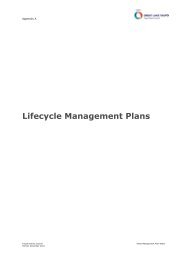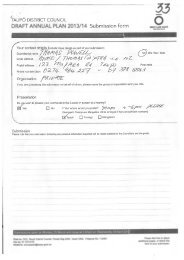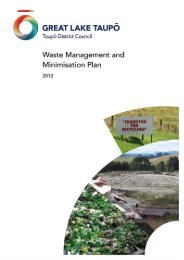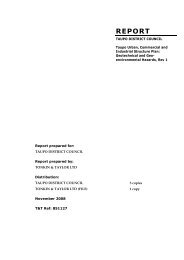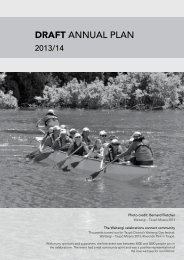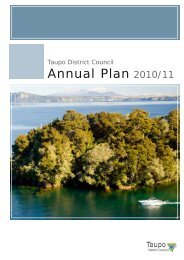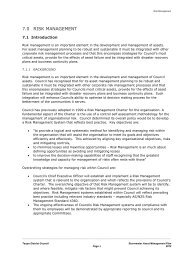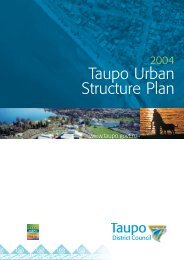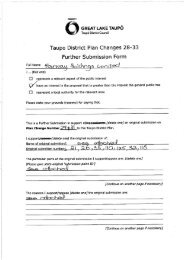Taupo District Flood Hazard Study - Whareroa Stream June 2012
Taupo District Flood Hazard Study - Whareroa Stream June 2012
Taupo District Flood Hazard Study - Whareroa Stream June 2012
Create successful ePaper yourself
Turn your PDF publications into a flip-book with our unique Google optimized e-Paper software.
<strong>Taupo</strong> <strong>District</strong> <strong>Flood</strong> <strong>Hazard</strong> <strong>Study</strong> - <strong>Whareroa</strong> <strong>Stream</strong><br />
Also using LiDAR topographic information, a two-dimensional MIKE21 model was<br />
established of the flood plain. The model covers an area of approximately 26ha along the<br />
river, and includes the majority of the <strong>Whareroa</strong> Village that could potentially be impacted by<br />
the river. The MIKE11 and MIKE21 components were dynamically coupled together using<br />
MIKE FLOOD. Model parameters were estimated using expert professional advice, and<br />
knowledge from previously calibrated hydraulic model of other rivers draining to Lake <strong>Taupo</strong>.<br />
The MIKE FLOOD model was then used to estimate the characteristics and extent of a 100-<br />
year average recurrence interval (ARI) event; incorporating the potential effects of climate<br />
change predicted by 2090. The February-March 2004 flood hydrograph measured in the<br />
<strong>Whareroa</strong> <strong>Stream</strong> at Fish Trap was also run through the model. Although no flood extent or<br />
water level data are available for calibration the results are useful for comparison. These<br />
results will also be valuable should calibration data become available at some stage in the<br />
future.<br />
6.2 Sensitivity analysis<br />
A sensitivity analysis was carried out on the input data and several hydrodynamic modelling<br />
parameters using the 100-year ARI event, plus the potential effects of climate change. This<br />
was to assess the effects and consequences of any errors, and therefore the confidence that<br />
can be placed in the model outputs. Inputs were varied by amounts corresponding to the<br />
realistic ranges which the various inputs might be expected to have when modelling a<br />
catchment such as the <strong>Whareroa</strong>.<br />
The sensitivity analysis confirmed that over the ranges tested, Manning’s n is the most<br />
sensitive parameter; however, no parameter had a significant effect on predicted flood levels.<br />
This is not surprising given the steeply sloping, and relatively confined, nature of the<br />
<strong>Whareroa</strong> <strong>Stream</strong>. The nature of the stream would suggest that channel geometry is the<br />
most important hydraulic control.<br />
The sensitivity analysis also showed that the effect of increasing the lake water level by 0.3m<br />
was only noticeable over the first 30m of the river upstream its mouth. Beyond this distance<br />
lake level has negligible impact on the water levels resulting from modelling the 100-year ARI<br />
with climate change flood hydrograph.<br />
Considering the accuracy of the input data, together with the lack of calibration data, the<br />
sensitivity analysis showed that the model produces sensible and realistic results. The<br />
model behaves in a realistic manner to small changes to the various inputs. The results of<br />
the hydraulic model can therefore be relied on to provide a good indication of the potential<br />
flood hazard in the <strong>Whareroa</strong> catchment.<br />
6.3 Effect of lake level on <strong>Whareroa</strong> <strong>Stream</strong> flooding<br />
Figure 6.1 shows a sketch of the longitudinal water surface profile along a river which flows<br />
into a lake. This is commonly referred to as the ‘backwater profile’ (Henderson, 1966).<br />
Beyond a certain distance upstream, the backwater profile for a given river discharge (flow)<br />
350855.00<br />
<strong>June</strong> <strong>2012</strong> 32



